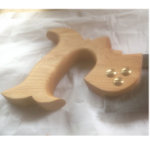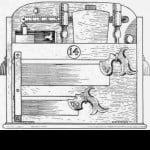Glue for clamp pads
Welcome! / Forums / General Woodworking Discussions / Tools and Tool Maintenance/Restoration / Glue for clamp pads
Tagged: Clamps, glue, glue freeze, joint freeze, USA made
- This topic has 17 replies, 10 voices, and was last updated 10 years, 11 months ago by
 Brett aka Pheasantww.
Brett aka Pheasantww.
-
AuthorPosts
-
Hello all
Simple one for you…
Cut some ply pads for my clamp heads but am getting fed up with them popping off the heads after a couple of uses.
Assume I’m using the wrong glues – before I blow any more money down B&Q can someone recommend one that works?
Cheers
Paul
 27 August 2013 at 10:53 pm #17153
27 August 2013 at 10:53 pm #17153Try contact Glue. Use in a well ventilated area fumes are quite strong. Apply even layer to block and to clamp head. Leave for 10 minutes touch dry then put in place bond will be pretty instant.
Contact glue a bit rubbery so should not break off.
Hi Paul,
I just did up my clamp pads the other weekend. I would recommend a medium to thick cyanoacrylate glue (a.k.a Super Glue or Krazy Glue 🙂 ). One thing I no longer do though is buy my CA glue from stores like Home Depot and such. The reason is because each manufacturer’s idea of thick and thin can differ, and sometimes the glues aren’t even labeled by viscosity. I’d rather not be left guessing each time I need more glue. I’d buy a brand that specifies different viscosity and stick with that brand, like one of these:
http://www.hobbylinc.com/ca_super_glue
I used this stuff:
http://www.hobbylinc.com/htm/hlc/hlc106.htm
Sometimes the pad face of the clamp itself is not truly flat (mines were concave just a bit). That’s why I prefer the gap filling property.
Since I’m not able to perfectly align the pads upon first contact, what I did was apply glue zig zag style the way Mr. Sellers lays PVA glue in the work bench videos, and then place it as precisely as I can using very light pressure only (practically just letting the tackiness do the holding), align it, and then press doown squarely. CA glue has an “activation film thickness”, and to an extent you have time to align before pressing the film down to thickness (we’re talking 3 or 4 seconds). This way it was much less stressful than using activator, which is a one-shot deal. I did use activator afterwards, not before. I just misted alcohol over the whole thing.
One other thing: do NOT use double sided tape! It may feel nice and sturdy at first, but you will then get to watch as the pads slowly creep off their surfaces as you tighten the clamps while gluing up your workbench top. Don’t ask how I know….*head hanging in shame*


[quote quote=17157]I used liquid super glue from the Dollar Tree in Texas and I haven’t lost any yet in 3 months and I’ve glued up 6 large drawers with them and put them all in a bucket

[/quote]
Nice. 🙂 Don’t mean to hijack this thread, but I notice for your workbench there you used a 2×12 board (maybe from Home Depot?) instead of a lamination for the aprons. That’s what I want to do too, but I wonder since it is green and not kiln-dried (like the 2×4’s) it might warp in the future. Did it work out ok for you?
Interesting – thanks for the replies – I did try searching the blogs but didn’t find anything specific. I also tried cynoacrylate, problem may be that I didn’t buy it – it’s a bottle I inherited from my old man along with his plane and some bent saws – maybe it’s time to invest in a new one.
 28 August 2013 at 9:26 am #17180
28 August 2013 at 9:26 am #17180Here’s the blog post where Paul details what he does to the aluminium clamps to get them to perform better, including a bit of detail on how to glue the pads on:
http://paulsellers.com/2011/11/4473/
George.

@juan-m I’ve had it for close to a year and I have not noticed any shifting or warping. I live in San Antonio Texax and we’ve have some crazy weather earlier in the year (30 in the morning and upper 80’s in afternoon) then later in the year super dry and then 100% humidity days. Now we’re hitting 100+ degrees and all is good. The bench is in my garage so it in the weather all the time. I’m happy with the route I took with the apron. My bench is solid. I did put two coats of shellac on it.

@mexiquite Thanks for the info. I’m going to use the 2×12’s.
28 August 2013 at 10:25 pm #17210I am so glad this was posted as I have just ordered ( 7 ) of the Harbor Freight clamps to give them a try. And of course I want to modify them like Paul’s. How would epoxy work or is this an over kill?
Steve

@smassiesr I found that the Harbor Freight clamps are very poorly made (most things can be fixed [twisting: adding wood inside, twist bar falls off: super glue or jb weld, spring comes out: replace with better spring, pin that holds top part of clap comes out: didn’t have the time or idea to fix that one, etc]. I just took 4 back today. Yes, they are half the price of the USA made Dubuque Aluminum claps http://www.thebestthings.com/newtools/uniclamps.htm but I’ve used both and if you want the clamps to really CLAMP something, the Harbor Freight clamps can’t put as much clamping pressure as the Dubuque ones. Even after they have been outfitted as per Paul’s suggestion, the Harbor Freight ones still come up lacking. I’ve used the USA made ones for 6 months and have not had a single problem and I bought my used.
Just some of my thoughts
Attachments:
You must be logged in to view attached files. 29 August 2013 at 4:02 am #17218
29 August 2013 at 4:02 am #17218Double sided carpet tape works well too.
A word on the Harbor Freight clamps because it does come up from time to time. I think that these clamps look identical to the UK ones we use except the heads are a different colour, but the UK ones rarely break where the HF ones will break if you are too heavy handed. I basically did see a difference in how people perceive clamps more in the US than the UK. The difference was that I saw people clamping out problems by applying greater pressure when the clamps should not be used to correct inaccuracies that leave gaps. The joints either right or it’s not. If it’s not, do it over or correct the error and use the clamps for what they are made for, to simply seat the joint gently and hold it until the glue is dry.
You should not dismiss the lightweight advantages of these cheap clamps. Few clamps give what these clamps do. When you are young and strong steel clamps weigh less when you lift a chair with eight clamps on it. When you are older and wiser,finesse and wisdom work simultaneously together.
I too have a set of Dubuque “Universal” clamps that I bought used, and I really really like them. I reach for them over my Parallel clamps because of the weight as Paul mentioned. They are so light weight and well balanced. The Parallels are so heavy that they are clumsy to maneuver.
As an experiment I used a hot glue gun to glue my pads on. My logic is that the glue is a bit more rubbery/flexible and perhaps more forgiving to the compressive pressure. Too early to tell, but the pads are holding and have survived two projects.

@paul-sellers good point on the clamping out problems. I think as my skills increase and I correct the errors that would leave a gap, the clamping power is less important. Of course it’s nice that the clamping power offered by Dubuque clamps is good just in case of glue/joint freezing 🙂 A few solid hits with the mallet and some clamp pressure and wallah! I remember the first time I saw you do it when a student had that problem and I was impressed. Nice trick to keep in the back pocket.
Here is the article where Paul explains glue freeze:
-
AuthorPosts
- You must be logged in to reply to this topic.
